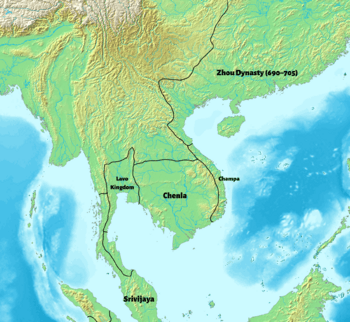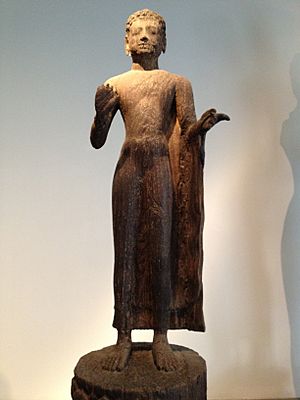Chenla facts for kids
Quick facts for kids
Chenla
ចេនឡា (Khmer)
|
|||||||||
|---|---|---|---|---|---|---|---|---|---|
| 550–802 | |||||||||

Mainland Southeast Asia in 700 CE
|
|||||||||
| Capital |
|
||||||||
| Common languages | Old Khmer, Sanskrit | ||||||||
| Religion | Hinduism, Buddhism | ||||||||
| Government | Absolute monarchy | ||||||||
| Historical era | Middle Ages | ||||||||
|
• Vassal state of Funan
|
550 | ||||||||
|
• Embassy to China
|
616/617 | ||||||||
|
• Independence
|
627 | ||||||||
|
• Separation of Water-Land
|
c. 707 | ||||||||
| 802 | |||||||||
| Currency | Native coins | ||||||||
|
|||||||||
| Today part of | Cambodia Laos Thailand Vietnam |
||||||||
Chenla (also called Zhenla) was an ancient kingdom in Southeast Asia. It existed from the late 500s to the early 800s. Chenla took over from an older kingdom called Funan and came before the famous Khmer Empire.
The name "Chenla" was given by the Chinese. It's not a name people in the region used for themselves. Historians today use "Chenla" to describe this time period, which is also known as "Pre-Angkorian." Many historians believe Chenla was not one big kingdom. Instead, it was likely a group of smaller states that sometimes worked together.
Contents
What Does the Name "Chenla" Mean?
The name "Chenla" (or "Zhenla") comes from Chinese records. It was the name the Chinese used for a place that sent gifts to their emperors. The actual meaning of "Chenla" is not fully known.
Some people think the name might mean "Pure Beeswax." This is because beeswax was a product from the region mentioned in Chinese writings.
History of Chenla
How Did Chenla Begin?
Chenla started as a smaller state under the Funan kingdom. Around the year 616 or 617, Chenla sent a group of people to visit China. Later, under its ruler, Citrasena Mahendravarman, Chenla became independent. It then took over Funan around 627.
Like Funan, Chenla was in an important spot for trade. It was where sea routes from India and East Asia met. This led to a lot of cultural exchange. For example, Chenla adopted a writing system from India.
The rulers of Chenla followed a tradition from Hinduism. Kings would choose a Sanskrit name of a god or a hero, adding "-varman" to it. This meant "protected by" and showed their connection to religious power.
Water Chenla and Land Chenla
Around the year 707, Chinese records say that Chenla split into two parts: "Land Chenla" and "Water Chenla."
- Land Chenla was the northern part.
- Water Chenla was the southern part, located near the Mekong Delta. It had good access to the river for trade.
However, being near the water also made Water Chenla easier to attack. By the late 700s, Water Chenla was controlled by the powerful Shailendra dynasty from Java. The last king of Water Chenla was likely killed around 790.
Many historians today believe that these "Water" and "Land" Chenla names might be confusing. They think there wasn't one big Chenla kingdom. Instead, there were many smaller states in the area until the Khmer Empire began.
How Did Chenla End?
The number of stone carvings and writings from this time became much fewer in the 700s. Some historians believe Chenla started to decline then. This was due to both internal problems and attacks from outside, especially from the Javanese.
The period of Chenla ended in 802. This is when Jayavarman II united the region and started the famous Khmer Empire.
Life in Chenla
What Was the Capital City?

Some scholars believe that the city of Champasak was where Chenla's ruling family came from. They also thought that Vat Phou in Laos was its main religious center. This idea came from old Chinese writings that mentioned a royal home near a mountain called Lingaparvata. Vat Phou is a large Khmer Hindu temple at the base of Mount Phu Kao, which looks like a lingam (a symbol of the Hindu god Shiva).
However, modern scholars are not sure if Phu Kao is the mountain mentioned. There are other hills in Cambodia that fit the description. So, it's still debated if Chenla was one united state or if Vat Phou was its main capital. Since there are not many writings from that time, it's hard to know for sure.
Who Were the Rulers?
At first, leaders were chosen based on their skills in battle and how many followers they had. But as rulers gained more power, leadership became more about family. Sons would take over from their fathers. Kings adopted the Hindu idea of a "Varman" king, meaning "protector king," which helped them control and lead.
We know about many of Chenla's rulers from old stone carvings.
- Bhavavarman I was one of the first independent rulers, around 550 to 598. He built a temple in 598.
- Mahendravarman (also called Citrasena) was Bhavavarman's brother. He is believed to have conquered Funan.
- Isanavarman I founded a new capital city called Isanapura (now Sambor Prei Kuk).
- Jayavarman I was the last ruler of a united Chenla, from about 657 to 681.
- After Jayavarman I, his daughter, Queen Jayadevi, ruled.
What Religions Did People Follow?
In Chenla, people mainly followed Hinduism and Buddhism.
- Hinduism was very popular. Kings used Hindu ideas to make their rule stronger. They often identified with Hindu gods like Vishnu (the creator) and Shiva (the destroyer). Sometimes, sculptures called Harihara, which combine Vishnu and Shiva, were made. This might show that people believed in a balance between creation and destruction.
- Buddhism also existed peacefully alongside Hinduism. This shows that the kings allowed different beliefs. Both religions helped the kingdom. Hinduism supported farming, and Buddhism helped with trade. This brought wealth to Chenla.
Religious Buildings
By the end of the 700s, the Chenla region had many temples and shrines dedicated to Hindu gods. Regular people helped take care of these places. They were expected to give land, goods, and even slaves to the temples. These temples were powerful, almost like companies, with their own land and people.
The design of these temples was influenced by the Gupta state in India. They were often made of brick and stone. Important temples used sandstone from the Kulen Mountains, which needed a lot of workers, including slaves, to move.
How Was Society Organized?
In Chenla, a person's social standing depended on their knowledge of language, especially Sanskrit. Sanskrit was seen as the language of the gods and was highly valued. People who knew Sanskrit could become officials or royal servants. Most people, however, did not know Sanskrit and worked in the fields to produce food for the temples and the kingdom.
This shows how much Hinduism influenced society. Sanskrit, linked to Hinduism, was more important than the local Khmer language.
Interestingly, women had important roles in Chenla. They were not seen as second-class citizens. Many women took part in religious ceremonies, were skilled craftspeople, and even held high official positions. This might be because families used to follow a matrilineal system, where heritage was traced through the mother's side.
Slavery in Chenla
Many common people worked as slaves. They cleaned, cooked, and built temples without pay. There were different types of slaves, depending on their origin and duties. Slaves could be bought, sold, or given away. They had no freedom, often because their parents needed money or had debts. This meant that if your parents were slaves, you would also be a slave, with no freedom of your own.
What Was the Economy Like?
Chenla's wealth came from growing wet rice and from using many workers. Productive lands were given to temples, where slaves worked the fields to make money for the temples. The kingdom had a good irrigation system, which helped produce a lot of rice. This extra rice was then traded.
International trade was also important. In the remains of an old port called Oc Eo (now in Vietnam), items from Rome, Greece, Persia, and India have been found. Indian traders were very successful, which might have made their religion and culture attractive to the people of Chenla.
List of Rulers
| Order | King | Reign |
| 1 | Bhavavarman I | c. 550 – c. 598 |
| 2 | Mahendravarman | c. 600 – 616 |
| 3 | Isanavarman I | 616 – 635 |
| 4 | Bhavavarman II | before 639 – before 657 |
| 5 | Candravarman? | ? |
| 6 | Jayavarman I | c. 657 – 681 |
| 7 | Queen Jayadevi | c. 681 – 713 |
| 8 | Sambhuvarman | 713 – 716 |
| 9 | Pushkaraksha | 716 – c. 730 |
| 10 | Sambhuvarman | c. 730 – c. 760 |
| 11 | Rajendravarman I | c. 760 – c. 780 |
| 12 | Mahipativarman | c. 780 – c. 788 |
Images for kids
See also
 In Spanish: Reino de Chenla para niños
In Spanish: Reino de Chenla para niños



